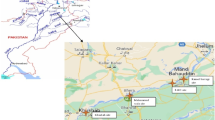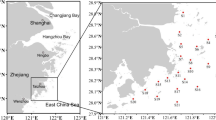Abstract
Heavy metal pollution was reported in commercially valuable freshwater edible fish in the Buriganga River, Bangladesh. The concentrations of As, Pb, Cd, Cr, Zn, and Cu were investigated in the muscle, gill, stomach, intestine, and liver of Heteropneustes fossilis caught at three stations to assess the degree of fish pollution by heavy metals. Significant differences in concentrations of analyzed elements were observed among different tissues, but not among the stations. The ranges of the measured concentrations (μg/g dry weight) in the tissues of H. fossilis were as follows: arsenic concentration was (0.2–0.4), (0.82–0.90), (3.29–3.99), (2.20–2.80), and (2.41–2.90), that of lead was (1.79–2.20), (4.95–6.55), (10.36–13.38), (5.74–9.70), and (18.20–18.79), that of cadmium was (0.3–0.4), (2.87–4.27), (1.03–1.63), (1.55–4.59), and (2.25–5.50), that of chromium was (1.40–1.70), (3.52–3.72), (2.28–5.29), (2.77–3.79), and (4.25–8.65), that of zinc was (24.47–28.82), (16.82–18.80), (20.22–22.20), (22.86–26.68), and (60.82–67.80), and that of copper was (7.80–8.50), (6.22–6.81), (38.21–44.25), (17.07–21.03), and (43.24–47.30) in the muscle, gill, stomach, intestine, and liver, respectively. This research showed that the liver appeared to be the main heavy metal storage tissue, while the muscle had the lowest levels of analyzed metals. The concentrations of metal in the muscles not exceeded the acceptable levels for a food source for human consumption.

Similar content being viewed by others
References
Agah, H., Leermakers, M., Elskens, M., Fatemi, S. M. R., & Baeyens, W. (2009). Accumulation of trace metals in the muscle and liver tissues of five fish species from the Persian Gulf. Environmental Monitoring and Assessment, 157, 499–514.
Ahmad, M. K., Islam, S., Rahman, S., Haque, M. R., & Islam, M. M. (2010). Heavy metals in water, sediment and some fishes of Buriganga River, Bangladesh. International Journal of Environmental Research, 4, 321–332.
Ahmed, K., Das, M., Islam, M. M., Akter, M. S., Islam, S., & Al-Mansur, M. A. (2011). Physico-chemical properties of tannery and textile effluents and surface water of River Buriganga and Karnatoli, Bangladesh. World Applied Sciences Journal, 12, 152–159.
Alibabić, V., Vahčić, N., & Bajramović, M. (2007). Bioaccumulation of metals in fish of Salmonidae family and the impact on fish meat quality. Environmental Monitoring and Assessment, 131, 349–364.
Amin, M. N., Begum, A., & Mondal, M. G. K. (2011). Trace element concentrations present in five species of freshwater fish of Bangladesh. Bangladesh Journal of Scientific and Industrial Research, 46, 27–32.
Begum, A., Amin, M. N., Kaneco, S., & Ohta, K. (2005). Selected elemental consumption of the muscle tissue of three species of fish, Tilapia nilotica, Cirrhina mrigala and Clarius batrachus, from the fresh water Dhanmondi Lake in Bangladesh. Food Chemistry, 93, 439–443.
Bervoets, L., & Blust, B. (2003). Metal concentrations in water, sediment and gudgeon (Gobio gobio) from a pollution gradient: relationship with fish condition factor. Environmental Pollution, 126, 9–19.
Cohen, T., Hee, S., & Ambrose, R. (2001). Trace metals in fish and invertebrates of three California coastal wetlands. Marine Pollution Bulletin, 42, 224–232.
Dural, M., Göksu, M. Z. L., Özak, A. A., & Derici, B. (2006). Bioaccumulation of some heavy metals in different tissues of Dicentrarchus labrax L, 1758, Sparus aurata L, 1758, and Mugil cephalus L, 1758 from the Camlik Lagoon of the eastern coast of Mediterranean (Turkey). Environmental Monitoring and Assessment, 118, 65–74.
Erdoğrul, Ö., & Erbilir, F. (2007). Heavy metal and trace elements in various fish samples from Sir Dam Lake, Kahramanmaraş, Turkey. Environmental Monitoring and Assessment, 130, 373–379.
EU Commission (2001) EU Commission Regulation as regards heavy metals. Directive 2001/22/EC, No. 466/2001/EEC as amended by regulation 221/2002/EC. Brussels: EU Commission
Fallah, A. A., Saei-Dehkordi, S. S., Nematollahi, A., & Jafari, T. (2011). Comparative study of heavy metal and trace element accumulation in edible tissues of farmed and wild rainbow trout (Oncorhynchus mykiss) using ICP-OES technique. Microchemical Journal, 98, 275–279.
FAO. (2000). State of world fisheries and aquaculture. Rome: FAO.
Farag, A. M., Nimick, D. A., Kimball, B. A., Church, S. E., Harper, D. D., & Brumbaugh, W. G. (2007). Concentrations of metals in water, sediment, biofilm, benthic macroinvertebrates, and fish in the boulder river watershed, montana, and the role of colloids in metal uptake. Archives of Environmental Contamination and Toxicology, 52, 397–409.
Islam, M.M., Akhtar, M.K., Masud, M.S. (2006). Prediction of environmental flow to improve the water quality in the river Buriganga (Proceedings of the 17th IASTED International conference on modelling and simulation, Montreal, QC, Canada).
Jarić, I., Višnjić-Jeftić, Ž., Cvijanović, G., Gačić, Z., Jovanović, L., Skorić, S., & Lenhardt, M. (2011). Determination of differential heavy metal and trace element accumulation in liver, gills, intestine and muscle of sterlet (Acipenser ruthenus) from the Danube River in Serbia by ICP-OES. Microchemical Journal, 98, 77–81.
JECFA (1982). Evaluation of certain food additives and contaminants. Twenty-sixth report of the joint FAO/WHO Expert Committee on Food Additives (WHO technical report series, no. 683), World Health Organization, Geneva.
JECFA (1989). Evaluation of certain food additives and contaminants. Thirty-third report of the joint FAO/WHO Expert Committee on Food Additives (WHO technical report series, no. 776), World Health Organization, Geneva.
JECFA (2000). Evaluation of certain food additives and contaminants. Fifty-third report of the joint FAO/WHO Expert Committee on Food Additives (WHO technical report series, no. 896), World Health Organization, Geneva.
Jent, S., Heing, J.S., Tate, C.M. (1998). Concentration distribution and composition of selected trace elements in bed sediment and fish tissue in the South Platte River basin, USA, 1992–1993. National Water-Quality Assessment (NAWQA) program report.
Karadede-Akin, H., & Ünlü, E. (2007). Heavy metal concentrations in water, sediment, fish and some benthic organisms from Tigris River, Turkey. Environmental Monitoring and Assessment, 131, 323–337.
Keskin, Y., Baskaya, R., Özyaral, O., Yurdun, T., Lüleci, N. E., & Hayran, O. (2007). Cadmium, lead, mercury and copper in fish from the Marmara Sea, Turkey. Bulletin of Environmental Contamination and Toxicology, 78, 258–261.
Kuddus, R., Quddus, M. M. A., & Shafi, M. (1995). Feeding and breeding habits of shing fish, Heteropneustes fossilis (Bloch). Dhaka University Journal of Biological Sciences, 5, 35–43.
Mohanta, M. K., Salam, M. A., Saha, A. K., Hasan, A., & Roy, A. K. (2010). Effects of tannery effluents on survival and histopathological changes in different organs of Channa punctatus. Asian Journal of Experimental Biological Sciences, 1, 294–302.
Mormede, S., & Davies, I. M. (2001). Heavy metal concentrations in commercial deep-sea fish from the Rockall Trough. Continental Shelf Research, 21, 899–916.
NRC. (1989). National research council recommended dietary allowances (10th ed., pp. 241–243). Washington, DC: National Academy of Sciences.
Olojo, E. A. A., Olurin, K. B., Mbaka, G., & Oluwemimo, A. D. (2005). Histopathology of the gill and liver tissues of the African catfish Clarias gariepinus exposed to lead. African Journal of Biotechnology, 4, 117–122.
Onsanit, S., Ke, C., Wang, X., Wang, K. J., & Wang, W. X. (2010). Trace elements in two marine fish cultured in fish cages in Fujian province, China. Environmental Pollution, 158, 1334–1342.
Ploetz, D. M., Fitts, B. E., & Rice, T. M. (2007). Differential accumulation of heavy metals in muscle and liver of a marine fish, (King Mackerel, Scomberomorus cavalla Cuvier) from the Northern Gulf of Mexico, USA. Bulletin of Environmental Contamination and Toxicology, 78, 124–127.
Pyle, G. G., Rajotte, J. W., & Couture, P. (2005). Effects of industrial metals on wild fish populations along a metal contamination gradient. Ecotoxicology and Environmental Safety, 61, 287–312.
Rashed, M. N. (2001). Monitoring of environmental heavy metals in fish from Nasser Lake. Environment International, 27, 27–33.
Shah, A. Q., Kazi, T. G., Arain, M. B., Jamali, M. K., Afridi, H. I., Jalbani, N., Baig, J. A., & Kandhro, G. A. (2009). Accumulation of arsenic in different fresh water fish species-potential contribution to high arsenic intakes. Food Chemistry, 112, 520–524.
Sharif, A. K. M., Alamgir, M., Mustafa, A. I., Hossain, M. A., & Amin, M. N. (1993a). Trace element concentrations in ten species of freshwater fish of Bangladesh. Science of the Total Environment, 138, 117–126.
Sharif, A. K. M., Alamgir, M., Mustafa, A. I., Hossain, M. A., & Amin, M. N. (1993b). Lead and cadmium contents in 10 species of tropical marine fish from the Bay of Bengal. Science of the Total Environment, 138, 193–199.
Sharif, A. K. M., Alamgir, M., Mustafa, A. I., Amin, M. N., & Safiullah, S. (1993c). Trace element concentrations in tropical marine fish from the Bay of Bengal. Science of the Total Environment, 138, 223–234.
Singh, R. K., Chavan, S. L., & Sapkale, P. H. (2007). Heavy metal concentrations in water, sediments and body tissues of red worm (Tubifex spp.) collected from natural habitats in Mumbai, India. Environmental Monitoring and Assessment, 129, 471–481.
Stoica, A., Pentecost, E., & Martin, M. B. (2000). Effects of arsenite on estrogen receptor-alpha expression and activity in MCF-7 breast cancer cells. Endocrinology, 141, 3595–3602.
Storelli, M. M., Barone, G., Storelli, A., & Marcotrigiano, G. O. (2006). Trace metals in tissues of mugilids (Mugil auratus, Mugil capito, and Mugil labrosus) from the Mediterranean Sea. Bulletin of Environmental Contamination and Toxicology, 77, 43–50.
Uysal, K., Köse, E., Bülbül, M., Dönmez, M., Erdoğan, Y., Koyun, M., Ömeroğlu, Ç., & Özmal, F. (2009). The comparison of heavy metal accumulation ratios of some fish species in Enne Dame Lake (Kütahya/Turkey). Environmental Monitoring and Assessment, 157, 355–362.
Walsh, D. F., Berger, B. L., & Bean, J. R. (1977). Mercury, arsenic, lead, cadmium, and selenium residues in fish, 1971–1973—National Pesticide Monitoring Program. Pesticides Monitoring Journal, 11, 5–134.
Wu, S. M., Jong, K. J., & Lee, Y. J. (2006). Relationships among metallothionein, cadmium accumulation, and cadmium tolerance in three species of fish. Bulletin of Environmental Contamination and Toxicology, 76, 595–600.
Yamazaki, M., Tanizaki, Y., & Shimokawa, T. (1996). Silver and other trace elements in a freshwater fish, Carasius auratus langsdorfii, from the Asakawa River in Tokyo, Japan. Environmental Pollution, 94, 83–90.
Yilmaz, F., Özdemir, N., Demirak, A., & Tuna, A. L. (2007). Heavy metal levels in two fish species Leuscius cephalus and Lepomis gibbosus. Food Chemistry, 100, 830–835.
Yılmaz, A. B., Sangün, M. K., Yaglıoglu, D., & Turan, C. (2010). Metals (major, essential to non-essential) composition of the different tissues of three demersal fish species from Iskenderun Bay, Turkey. Food Chemistry, 123, 410–415.
Acknowledgements
The authors are grateful to the chairman of the Department of Zoology and Applied Chemistry and Chemical Engineering, University of Dhaka, Bangladesh for providing the laboratory facilities during the progress of this work. The authors are also delighted to express their gratefulness and sincerest thanks to the authority of Bangladesh Atomic Energy Commission, Dhaka, Bangladesh for providing laboratory facilities to analyze fish samples using conventional technique.
Author information
Authors and Affiliations
Corresponding author
Rights and permissions
About this article
Cite this article
Begum, A., Mustafa, A.I., Amin, M.N. et al. Levels of heavy metals in tissues of shingi fish (Heteropneustes fossilis) from Buriganga River, Bangladesh. Environ Monit Assess 185, 5461–5469 (2013). https://doi.org/10.1007/s10661-012-2959-4
Received:
Accepted:
Published:
Issue Date:
DOI: https://doi.org/10.1007/s10661-012-2959-4




